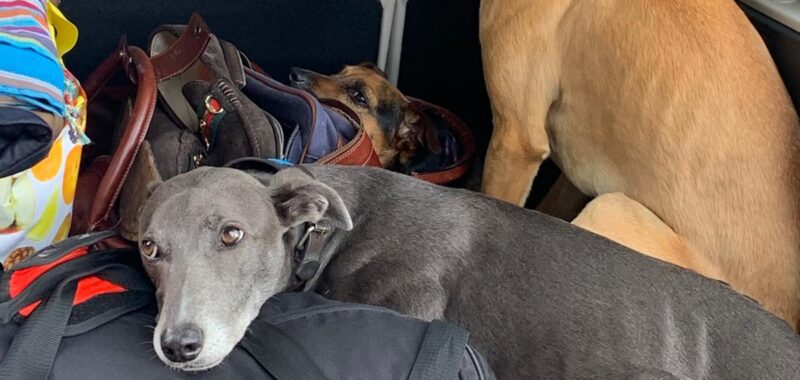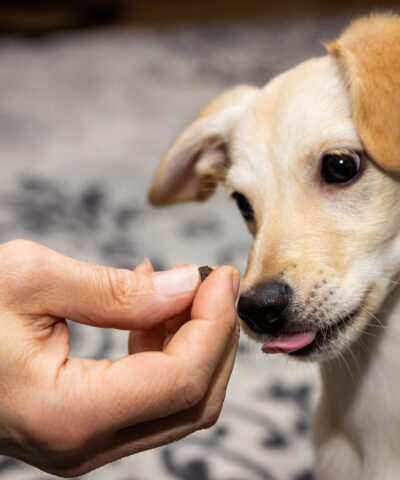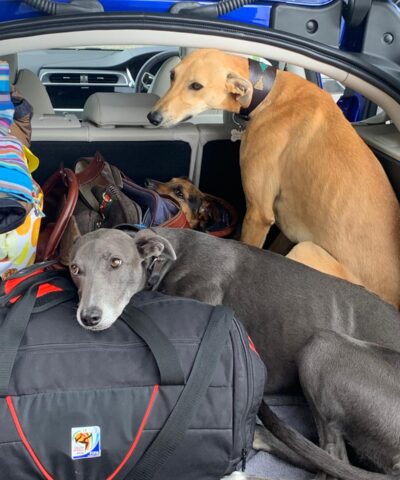Few things tug at your heartstrings more as a dog owner than seeing your furry companion struggle with separation anxiety. It’s why you come home to something that resembles a rubbish tip rather than your home, despite your pup’s well-intentioned efforts to cope with your absence. This guide will delve into the complex world of separation anxiety in dogs, offering insight, empathy, and strategies to create a calmer environment for your loyal friend when you’re not around.
What is Separation Anxiety in Dogs?
Unlike the myth that only rescued or rehomed dogs experience separation anxiety, this condition can affect dogs from all backgrounds; in fact, it’s often those dogs that have had the most privileged (dare I say it, spoilt) upbringing that can be the most destructive. At its core, separation anxiety is an excessive response to a dog’s fear of being alone, borne from an inability to cope when you leave them. This fear triggers unwanted behaviours as your dog copes with the stress of separation. While this may sound like a predicament with no relief, understanding its nuances and triggers can pave the way for a solution.
The Complexity of Your Dog Emotions
As social creatures, dogs thrive on human company and are biologically hardwired for familial bonds with their human “pack.” When alone, some dogs feel a profound sense of isolation that mirrors the anxiety a human child may feel when apart from a caregiver. This analogy helps put into perspective the depth of emotion that canines experience and the challenges they may face when we humans go about our daily activities.
Signs Your Dog Demonstrates Separation Anxiety
Each dog is an individual with a unique personality, and so their demonstrations of anxiety can vary. It’s important to recognise these signs, which may include:
- Destructive Behaviour – From tearing through trash bins, pulling valuables off sideboards, and meticulously pulling apart your new couch, the destruction is a dog’s desperate expression, hoping to bridge the gap between their panic and your presence.
- Barking or Excessive Vocalisation – The soundtrack of separation anxiety can range from whining and barking to howling as your dog’s vocal cords echo their unhappiness.
- Potty Accidents Indoors – Contrary to training and habit, a well-behaved dog may regress when coping with separation anxiety, leaving behind messes as a poignant reminder of their distress.
- Escape Artist Antics – Some dogs take desperation to the next level, attempting Houdini-like escapes through windows, doors, or even walls (yes, it can happen), risking injury in their fervour to reunite with you. We have a dog called Smoothie, who, as a puppy, we nicknamed Smoothie Houdini. Initially, we thought it was amusing, even cute when she would appear out of nowhere to be beside us, proudly showing off her ability to find a way out of every veritable form of puppy Fort Knox. However, the novelty soon wore off as we realised it was all linked to a broader form of separation anxiety.
- Unsettling Coping Mechanisms – Licking paws raw, pacing, or overgrooming are some self-soothing methods dogs employ when they can’t soothe their separation-induced stress.
Why Do Dogs Develop Separation Anxiety?
While it’s not fully understood why some dogs develop separation anxiety and others don’t, several factors can contribute to its onset.
Abundant Time Together
The pandemic brought about a significant change for pet parents, resulting in increased time spent together. During the lockdown era, many purchased and raised puppies while working from home, creating a close bond. However, sudden separations can now be jarring, causing confusion and anxiety. In the post-pandemic world, as pet parents return to physical work locations, vets have noticed a sharp increase in separation anxiety cases.
Changes in Routine or a lack of Routine
Dogs are creatures of habit. A sudden shift in your schedule can trigger uncertainty and anxiety when the new schedule doesn’t involve them.
Dogs that lack a consistent daily routine may find their typical day unsettling due to its unpredictability. As a result, this can trigger separation anxiety when they are unexpectedly left alone.
Rescue Dog Trauma
For some rescue dogs, previous experiences have wired their brain to see being alone as a threat. The psychological scars don’t heal overnight, and sometimes, not at all.
Illness and Aging
Physical discomfort, declining sensory perception, or cognitive issues can manifest as separation anxiety, with your dog feeling safer in your constant presence.
What Triggers Separation Anxiety in Dogs?
Understanding what triggers your dog’s response is critical to addressing the issue. Common triggers include:
- Pre-Departure Cues and Going Away – While you’re gathering your keys or putting on your coat, your dog picks up on these cues, signalling the impending loneliness and initiating their angst-ridden reaction. The impact of suitcases coming out can be even more dramatic. Undoubtedly, many of you have witnessed the look of utter distraught as soon as they appear. One day, while packing to go away, we returned upstairs to find all three dogs comfortably settled inside the suitcases. My wife Emily exclaimed, “It almost makes me want to cancel our holiday, seeing how sad they look.” On another occasion, all three of them somehow squeezed themselves into the back of the car alongside the suitcases despite no perceivable room. We have now found that the best way to work around this is not to let the dogs see the suitcases or the packed cars.
- Long-Term High-Stress Environments – Persistent stress within the home environment can establish a foundation of anxiety that manifests as separation anxiety when you are away. Dogs, being remarkably perceptive and sensitive beings, are susceptible to the effects of stress, much like humans. It is essential to understand that stress may cause unhappiness and unease in them, exacerbating separation anxiety.
- History of Abandonment – Dogs with a history of being abandoned or rehomed may have accumulated emotional baggage, with every separation from a human representing the potential for repetition of the past trauma.
- Prolonged Absence – Like pre-departure cues, the length of your absence can impact your dog’s reaction. More prolonged absences often result in more noticeable distress upon return. I am sure many of you have been in the situation of seeing your dogs go into an almost state of panic or depression as soon as the suitcases come out. Many dogs (correctly) associate the appearance of a briefcase with a prolonged absence.
How to Reduce Separation Anxiety in Dogs
Now comes the pivotal part—how can you help soothe your dog’s separation anxiety? Let’s explore some solutions that can gradually alleviate the stress and fear associated with your absence.
Gradual Desensitisation
Teach your dog that departures don’t spell doom by practising short, frequent absences, gradually increasing the time spent apart as they become more comfortable.
Enrichment and Exercise
Incorporate physical and mental enrichment activities to tire out your pup before you leave. Puzzle toys, interactive feeders, and long walks can help them unwind and rest rather than fret in your absence.
Create a Safe Space
A comfortable, secure den-like space can provide solace when you’re away. Favoured toys, familiar scents, and calming music in this area can help your dog associate alone time with positive experiences.
Seek Professional Assistance
If your dog’s separation anxiety is severe, professional help may be necessary. A veterinarian or dog behaviourist can recommend therapy, training, or even medication to help your dog overcome its fears.
Products That Help
Various products are designed to help alleviate dog anxiety, from pheromone diffusers and calming collars to thunder vests and separation-specific training aids.
Food that can help
There are also specially formulated dog foods that can help. Typically, these are lower on very high energy-inducing ingredients and often contain natural calming ingredients like camomile, hemp and valerian. Pouch and Mutt Calm and Relaxed is a great product, but of course, we would naturally recommend our own Green Pantry relaxation and calm product, which is made with a super tasty blend of duck and turkey, with blueberry and sweet potato.
Patience and Consistency
Remember, patience is vital. Consistently employing the strategies above, monitoring your dog’s progress, and making adjustments as needed can go a long way in managing separation anxiety.
Case Study: Smoothie’s Transformation
We have a personal case study: Smoothie, sometimes referred to as Smoothie Houdini, due to her earlier-mentioned knack for escaping. To our surprise, we discovered that Smoothie suffered from severe separation anxiety. Discovering this was a shock because we had never encountered this issue with our previous dogs. Moreover, her mother, Cosy, who is still with us, is one of the most independent and resilient dogs you could ever meet, and she wouldn’t know what separation anxiety would be if it walked right up to her! However, upon closer examination, we realised that several factors contributed to Smoothie’s anxiety.
Firstly, she never left home as she was a homebred puppy. Secondly, shortly after her birth, we entered the first lockdown, which meant we spent the earlier mentioned ‘abundant time together‘. Unlike our other two dogs, Cosy and Mouse (who had free roam downstairs when we were out), Smoothie was not accustomed to being alone. Consequently, once the lockdown was over, we experienced every imaginable separation anxiety disaster: shredded sofas, valuables pulled off sideboards, countless chewed pens, and wooden furniture marked by gnashers. If you can think of it, it probably happened.
However, once we identified the issue, we sought a remedy. The solution came in the form of a combination of routine and creating a safe space, which, in our case, was partly the same. We started putting all the dogs in the same room at the same time every day. In this room, we provided plenty of beds, toys, chews, etc. We tried to make the room as dog-comfortable as possible and, simultaneously, reduce the level of consumables that could be destroyed in the event of a separation anxiety occurrence.
I also moved my home office there to deepen the positive association with the room further. The idea was that spending an entire work-from-home day in that space would strengthen Smoothie’s positive memories. The results have been remarkable with the established routine of going into the room after the morning walk, along with it being her designated safe space. It has been nearly six months since we last experienced a separation anxiety event.
Granted, this is based on a sample size of one, but the combination of routine and creating a safe and happy space for Smoothie has proven effective in overcoming her separation anxiety.
The Road to Recovery
Remember, overcoming separation anxiety is a marathon, not a sprint. The love and patience you invest in understanding and aiding your dog will alleviate their suffering and deepen the bond you share. Each small victory – a non-destroyed shoe, a calmer welcome, a contented nap – is a significant step toward a happier, more balanced life for you and your pet.
Separation anxiety in dogs is a multi-layered challenge, but armed with knowledge and empathy, you can help your best friend navigate the complex world of loneliness. By recognising the signs, understanding the causes, and implementing constructive strategies, you can create an environment where your dog feels secure, even in your temporary absence.
To all the pet parents on the path to comforting their anxious pups, know you’re not alone in this journey. With the right approach, positive reassurance is just around the corner. The trip to peaceful coexistence with separation anxiety takes time but ultimately leads to a dog that is as joyful on their own as they are with you. Your companionship is the cure they crave; let’s help them find that same comfort within themselves.
Written By Tom and the Green Pantry Team, ably assisted by their K9 support team.





